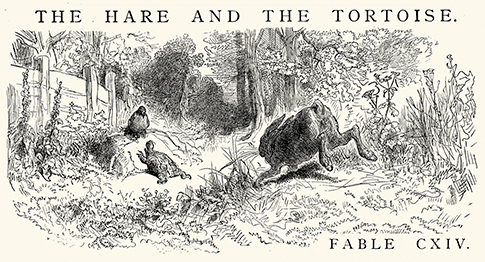Hares, Tortoises, and the Persistence of Behavior

Remember Aesop’s fable about the hare and tortoise? The tortoise got tired of the hare’s constant bragging about how fast he ran, so the tortoise challenged the hare to a race. The tortoise won, leaving the hare to reflect on how one shouldn’t "brag about your lightning pace, for Slow and Steady wins the race!" The moral of the story is that, in the end, slow steady responding often wins out over higher rate, “flashier” modes of responding. There are parallels to this fable in contemporary research on behavioral persistence. The question boils down to this: Is higher- or lower-rate behavior more persistent? That is, does slow and steady responding “outpersist” fast and flashy behavior?
 We define persistence as the resistance of behavior to change in the face of challenges to that behavior. Challenges to behavior includes changes in the quality or amount of reinforcement and the intrusion of distracting events. Given a constant challenge, such as the removal of reinforcement (a.k.a. extinction), persistence also is affected by the conditions under which the behavior is maintained before its resistance to change is examined. Behavior that is reinforced more frequently or with higher-quality reinforcers often is more resistant to change than is behavior reinforced less often or with reinforcers of lesser quality. negating the wisdom embedded in the fable. Because better reinforcers also maintain faster responding than do less effective reinforcers, it is tempting to conclude that responding faster or more is more persistent in the face of challenges than is slower responding,
We define persistence as the resistance of behavior to change in the face of challenges to that behavior. Challenges to behavior includes changes in the quality or amount of reinforcement and the intrusion of distracting events. Given a constant challenge, such as the removal of reinforcement (a.k.a. extinction), persistence also is affected by the conditions under which the behavior is maintained before its resistance to change is examined. Behavior that is reinforced more frequently or with higher-quality reinforcers often is more resistant to change than is behavior reinforced less often or with reinforcers of lesser quality. negating the wisdom embedded in the fable. Because better reinforcers also maintain faster responding than do less effective reinforcers, it is tempting to conclude that responding faster or more is more persistent in the face of challenges than is slower responding,
But, not so fast. Fast responding and better reinforcers are confounded in our example above. To get a clearer picture of how responding affects persistence, we would have to deliver the same quality reinforcer for responding occurring at either a high or low rate, with other things (like the schedule of reinforcement) held constant. When we do this, voila, it turns out that the fable is correct: lower response rates are more persistent than higher response rates. There is strong experimental support for this conclusion, but, in fairness, not everyone agrees on this conclusion (at least not yet).

If the tortoise-and-hare outcome continues to be confirmed as research continues, it has some useful implications for application. On the one hand, in predicting treatment outcomes, behavior that is infrequent may be more resistant to change than higher-rate behavior. One speculation falling out of this analysis is that, other things being equal (which, of course, they rarely are), children who are responding at low rates – for example, who are withdrawn and behaviorally depressed - may be more resistant to treatment than are children who have other types of behavior problems reflecting high rates of behavior, such as inattention and overactivity. On the other hand, making children more engaged or persistent at tasks could be a matter of reinforcing responding at slower rates and of not reinforcing, for example, rapid task completion. These observations regarding application are simply speculations at this point, but they illustrate some of the directions that the tortoise-and-hare problem might take in affecting positively the lives of people.



